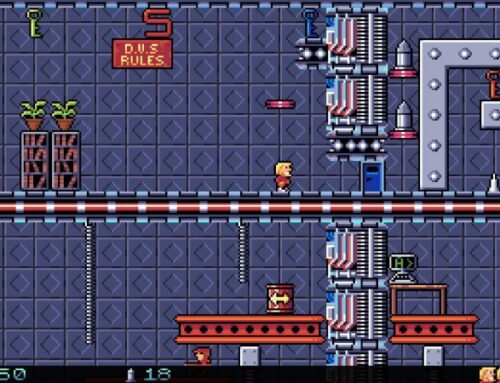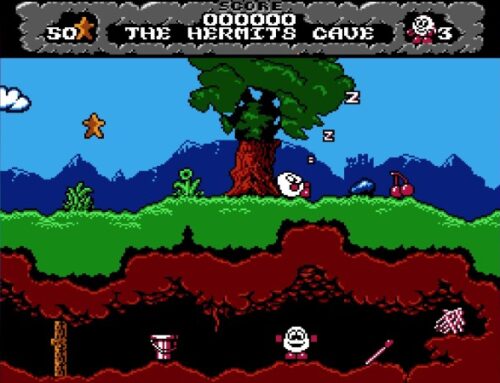Old-school handhelds may not be the first place you’d think to look for either horror games or adventure games — but there are occasional examples of both. On the Game Boy, for example, we have “modern retro” title Deadeus, which is great. And on the Atari Lynx, we have Dracula: The Undead.
I would not necessarily describe Dracula: The Undead as a particularly good adventure game, but it is an interesting game to explore — and actually a quite effective horror game, given the inherent limitations of the platform on which it was released. So let’s take a closer look!

In Dracula: The Undead, you take on the role of Jonathan Harker, one of the main characters from the original Bram Stoker novel, and probably the most heroic estate agent in the history of literature. The story begins as Harker arrives at Dracula’s castle in order to talk business with him, and the initial setup is quite similar to what unfolds in the book: while Harker is keen to get straight to talking shop, Dracula informs his guest that he has business of his own to conduct during the day, and will attend him later that evening.
From here, Harker is left to wander the halls of Dracula’s castle with a stern warning to not, under any circumstances, attempt to enter any locked rooms. The castle is old and falling apart, after all, and the doors are, of course, locked for his own safety and not at all to cover up any sort of evidence that the Count might be a vampire or something. Absolutely not.
Gameplay from hereon consists of manually moving Harker around the various environments, then making use of a two-part menu at the bottom of the screen to construct “sentences” in order to perform actions. The left part of the menu consists of a series of verbs (examine, open, close, get, that sort of thing) while the right part of the menu consists of nouns — both objects that Harker has in his inventory, and the object that he is standing next to, if any.

It’s a slightly cumbersome interface if you’re more accustomed to elegant point-and-click interfaces on home computers — but it’s an effective means of accomplishing the same thing using the limited controls of the Lynx.
There’s also a sequence that crops up several times over the course of the game in which you need to climb along the outside wall of Dracula’s castle; this acts as a simple “maze” sequence and there’s no actual means of falling off. It’s quite fun the first time, but given you have to do it numerous times as the game progresses, it does get a little tiresome after a while!
Presentation-wise, Dracula: The Undead is pretty neat. Bearing the limitations of the Lynx in mind, developer Hand Made Software chose to depict the entire experience in sepia tones. This gives the game both a distinctive sense of atmosphere and a sense that we’re enjoying a story from some time ago. There’s nice use of the Lynx’s hardware scaling on Harker’s sprite, too — though he does become amusingly pixelated and distorted when scaled to larger than his “normal” size!
The background music is repetitive but very atmospheric, and between the visuals and the audio the game goes a long way to creating a genuinely menacing atmosphere using relatively limited technology. It works well; while I’d hesitate to describe Dracula: The Undead as truly “scary”, it’s certainly got a nicely unsettling vibe to it.

The fact that numerous cutscenes are supposedly narrated by “Bram Stoker” himself is also a nice touch — from a technical perspective, it allows events that would be complex to animate to be depicted using simple text, while from a stylistic perspective it helps with a sense of “storytelling”.
Unfortunately, the storytelling side of things is a bit of a weak point of Dracula: The Undead. While the premise of the game is straight out of the original book, there’s not really any sort of narrative or character development as the game progresses.
Harker is a completely blank slate of a protagonist, and his exceedingly boring default response of “it’s a fine [noun]” when looking at something the game doesn’t have a specific description for is an almost unforgivable sin when you consider both Sierra and LucasArts had been putting out games packed with personality for years at this point.

If anything, the game feels kind of half-finished. There’s only a single dialogue sequence in the entire game, and it feels like this could have been used more extensively. The Brides of Dracula show up in a dramatic cutscene, but are then never seen again. And perhaps worst of all, the game just sort of fizzles out at the end; Harker escapes Dracula’s castle, and then you get one of two endings depending on whether or not you remembered to take notes at every important juncture during the previous hour of gameplay.
There’s no dramatic final confrontation, no real climax to what’s going on — just a bit of a wet fart of an ending, and the promise that this could have been so much more.
Whether or not this is down to a lack of funds, lack of development time or simple lack of space on the Lynx cartridge isn’t really clear — the development of this game wasn’t especially well-documented, and the Lynx in general is a bit “niche interest” for many gaming historians — but, as it stands, Dracula: The Undead is a good example of a game where the developers’ ambitions perhaps couldn’t quite match up to the reality of developing for the host platform.

None of this is to say that Dracula: The Undead isn’t worth playing, mind. As a partially successful attempt to bring a genre of gaming typically associated with home computers to a handheld platform, it remains a thoroughly interesting game to explore. And with its modern rerelease as part of the Atari Lynx Collection 1 cartridge for the Evercade, you can do just that. What’s more, playing it on the Evercade provides you with one thing that the Lynx original never had — the ability to save!
Playing an adventure game in which you can die without the ability to save? Now that’s scary.





